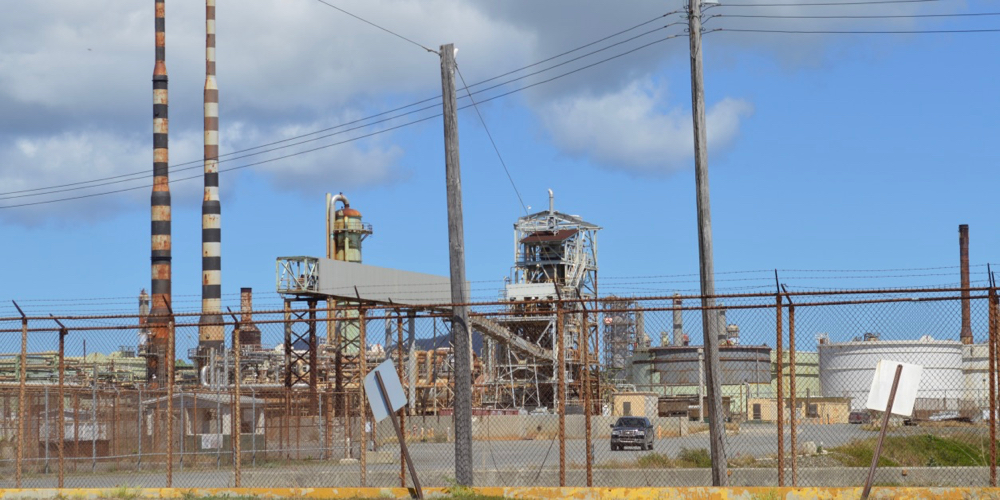
Limetree officials said on Monday that the gas that burned noses on much of St. Croix on April 22 did not contain dangerous hydrogen sulfide, but the less dangerous pollutant sulfur dioxide, produced from burning hydrogen sulfide.
The latest report added new information about what exactly happened, but seems to conflict with the Department of Planning and Natural Resources report “that its Air Quality Management Program staff had responded to citizen’s complaints and found the refinery was exceeding its limit of hydrogen sulfide emissions.”
In a later release, DPNR reported “elevated concentrations” of hydrogen sulfide “in the No. 8 flare header at the Limetree Bay Facility.”
U.S. Occupational Safety and Health Administration guidelines set similar limits to both gases. It allows up to 10 parts per million of hydrogen sulfide, or five parts per million for sulfur dioxide, in the air for an eight-hour workplace exposure. OSHA rates amounts higher than 100 parts per million as “immediately dangerous to life and health” for both gases.
But hydrogen sulfide is considered much more dangerous. Hydrogen sulfide is heavier than air and can accumulate in low areas. While it smells at first, exposure at low levels quickly becomes undetectable, so you don’t know that the concentration is increasing. That can lead to workers being suddenly, unexpectedly overwhelmed. And it is flammable. It is responsible for a significant number of workplace deaths.
Sulfur dioxide, on the other hand, is highly irritating and noxious and burns the eyes, nose, throat and lungs at high concentrations, which lets you know it is there and getting worse. It disperses into the air more. And it does not burn. It does lead to particulate air pollution and is a major cause of acid rain. It can trigger asthma and breathing difficulties.
Whether entirely sulfur dioxide or partly hydrogen sulfide, the refinery’s gas release led to numerous complaints and the brief closure of several St. Croix public schools.
There is a long history of smell-related school closures on St. Croix.
St. Croix residents reported strong odors late that night through early the next morning. One source who asked to remain anonymous said they were driving near the refinery around 10:30 p.m. on April 22.
“I think I was fortunate to be driving when I smelt the sulfur, so my reaction was more like ‘Wow that smells extremely strong!’ I didn’t cough, but if I were in a home downwind from the refinery my reaction might have been a bit more intense,” the person said.
Another person reported being awakened at their Estate La Grange, Frederiksted, home at 4 a.m. by an odor that persisted past 8 a.m. The person had no nausea or burning eyes but had a mild headache for several hours.
According to a release from Limetree, the refinery had “an operating upset in the sulfur processing part of the refinery,” which then “caused a pressure increase in some equipment, resulting in the opening of a pressure relief valve, and sending an unusually high amount of sulfur-containing gases to the flare, where they were safely burned.”
The refinery’s statement says the pressure relief valve and flare are designed to work this way to protect the refinery workers and community.

“When the sulfur-containing gases were burned in the flare, sulfur dioxide was produced. This unusually high level of sulfur dioxide coming from the flare, unfortunately, resulted in an odor that was evident to parts of the neighboring community. Sulfur dioxide has an odor similar to a struck match and can be smelled even at a very low concentration level, which is far below the level normally considered dangerous to health,” according to the release.
The refinery workers reportedly fixed the problem, eliminating the source of the odor.
“We are committed to investigating fully the reasons for this event in cooperation with local regulators, and to implement improvements to prevent it from happening again,” the company’s release said.
Like many refineries, the Hovensa plant had a long history of flares, sulfurous odors and aerosol sprays of oil that impacted neighboring residents. And the Limetree plant had a large flare not long before restarting.
Details on the history of releases at the former Hovensa refinery are available on these sites:
– DPNR, Hovensa Respond to ‘Smell,’ Water Issues
– Workers Evacuated as Hovensa Tank Spews Oily Steam Cloud
– Hovensa Completes Cleanup from October Oil Spray
– Hovensa Sprays Oil For Third Time This Year
In August of 2011, Hovensa released just over one ton of hydrogen cyanide gas out of its stacks.
Also in 2005, the refinery released an oily steam cloud forcing some employees to be evacuated.
In December of 2010 and January of 2011, Hovensa had two actual leaks of hydrogen sulfide.
Residents of areas near the refinery have long complained of health impacts. In 2010, several Estate Profit residents filed suit.





